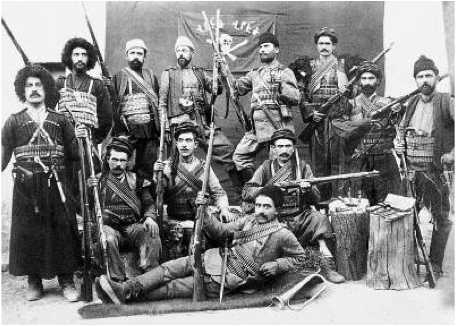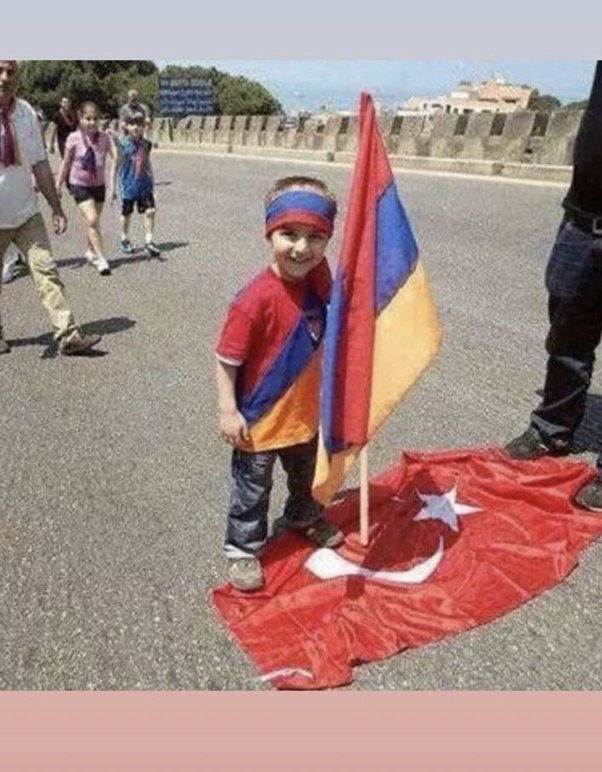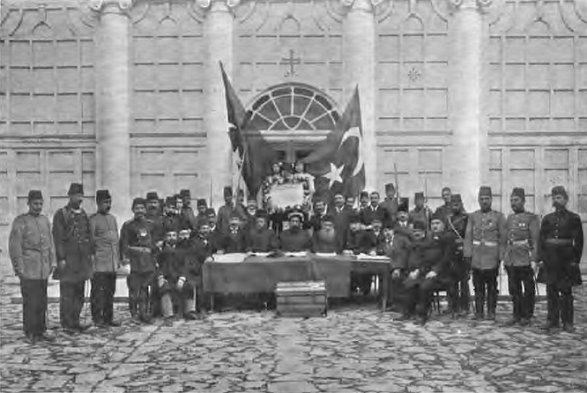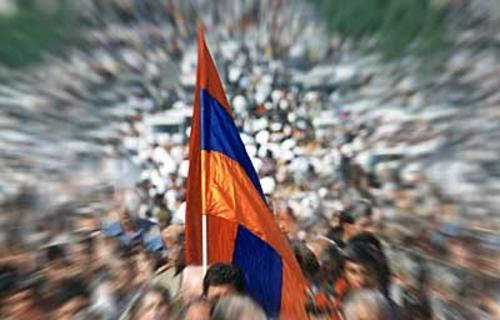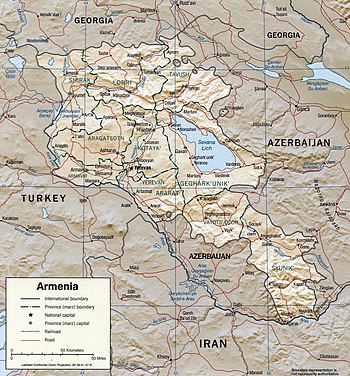Mr. Mehmet Sukru Guzel
Some Notes on the report of Armenia State given to the United Nations Human Rights CommissionSome Notes on the report of Armenia State given to the United Nations Human Rights Commission[1]Paragraph 11,In paragraph 11 of the report, it is written that “Taking advantage of the situation resulting in the First World War, the Young Turks government planned and carried out the genocide of Armenians inhabiting in the territory of the Ottoman Empire. Within the period of 1915-1923 nearly one and a half of more than two millions were killed and the rest were either forcibly converted to Islam or found refuge in different countries of the world. Western Armenia was deprived of its native Armenian population.”Armenia claimed of genocide against the Ottoman Armenians in his report. If Armenian is to claim a genocide in a report given to the United Nationst, then Armenia shall apply to the United Nations for the procedure for Genocide. Since both Turkey (31 July 1950) and Armenia (23 June 1993) are States parties to the Genocide Convention, it would be possible to invoke article VIII, which provides that any contracting party may call upon the competent organs of the United Nations to take such action.[2]
And if there is a claim of genocide in a report given to the United Nations then Armenia shall accept the procedure of United Nations to the Right to the Truth principles for the genocide claims. Armenia shall want Truth Commission based on “the Right to the Truth Concerning Gross Human Rights Violations and for the Dignity of Victims” .
As written in the resolution adopted by the United Nations General Assembly on 18 December 2013[3], United Nations welcomes the establishment in several states of specific judicial mechanisms and non-judicial mechanisms, such as truth and reconciliation commissions, that complement the justice system, to investigate violations of human rights and violations of international humanitarian law.. Also in his resolution United Nations encourages the States concerned to disseminate, implement and monitor the implementation of the recommendations of non-judicial mechanisms, such as truth and reconciliation commissions, and to provide information regarding compliance with the decisions of judicial mechanisms.
In recent years, Latin American countries have sought to come to terms with prior periods of widespread human rights violations, relying increasingly on investigatory commissions. Investigatory efforts have been undertaken by democratically elected governments that replaced military dictatorships, by UN-sponsored commissions as part of a UN-mediated peace process, and by national human rights commissioners. Truth commissions were formed in Chile and El Salvador, an investigatory effort in Honduras, and in Guatemala
The Truth Commission for El Salvador (Spanish: Comisión de la Verdad para El Salvador) was a truth commission established by the United Nations to investigate and report on human rights abuses during the civil war in El Salvador (1980–1992).
The Commission was established by the 1992 Chapultepec Peace Accords that brought the civil war to an end. Article 2 of the Accords stipulates, “The Commission shall have the task of investigating serious acts of violence that have occurred since 1980 and whose impact on society urgently demands that the public should know the truth”.
The Commission was composed of three international notables selected by the Secretary General of the United Nations in consultation with the parties: Belisario Betancur, former president of Colombia; Reinaldo Figueredo Planchart, former foreign minister of Venezuela; and Thomas Buergenthal, Professor of Law, George Washington University. The Commission was not established as a judicial body. Instead it was given six months under the terms of the Salvadoran peace accords to carry out four main tasks: to clarify the worst human rights abuses of the war by all sides; to study with special care the impunity with which the Salvadoran military and security forces committed abuses; to make legal, political or administrative recommendations to prevent a repeat of past abuses; and, finally, to stimulate national reconciliation. Both the guerrillas and the government committed themselves to carry out the Commission’s recommendations. In seeking, as mandated, the most thorough accounting possible of human rights abuses in the war, this report names the institutions and those individuals whom the Commission found responsible in the cases it studied.
The Commission received direct testimony from 2000 sources relating to 7000 victims and information from secondary sources relating to more than 18,000 victims. Given this amount of testimony, the Commission could only deal with a small portion of the thousands of abuses committed in the war. It chose to select a sample of cases that either reflected the most shocking events of the conflict or formed part of a broader, systematic pattern of abuse.
On March 15, 1993, the commission published its report From Madness to Hope: the 12-year war in El Salvador.
Also Guatemala’s civil war claimed over 200,000 lives. A United Nations sponsored truth commission, the Historical Clarification Commission, created after the war ended in 1996. The legal basis of the Commission was by the General Peace Agreement of 29 December 1996 between the guerrillas, Unidad Revolucionaria Nacional Guatemalteca (UNRG, Guatemalan National Revolutionary Unit ) and the government of Guatemala as part of the peace agreements which had been consolidated and confirmed which is known as Oslo Agreement.
The mandate of the Commission was essentially threefold;
1 – To clarify with all objectivity, equity and impartiality the human rights violations and acts of violence that have caused the Guatemalan population to suffer, connected with the armed conflict
2 – To prepare a report that will contain the finding of the investigations carried out and provide objective information regarding events during this period covering all factors, internal as well as external.
3 – Formulate specific recommendations to encourage peace and national harmony in Guatemala. The Commission shall recommend in particular, measures to preserve the memory of the victims, to foster a culture of mutual respect and observance of human rights and so strengthen the democratic process.
The United Nations had provided generous support, although the Commission was not a United Nations body.
The Historical Clarification Commission’s report, titled” Memory of Silence” was formally presented on February 25, 1999. It estimated that over 200.00 people were killed or disappeared as a result of conflict. According to its findings, 93 percent of human rights violations and acts of violence are attributable to actions by state, while 3 percent can be attributed to the guerillas. 85 percent of all registered violations are attributable to the army, with 18 percent to the civil patrols. It also concludes that acts of genocide were committed against Mayan Groups by agents of state of Guatemala between 1981 and 1983. “Memory of Silence” further details cases of extrajudicial executions and forced disappearances, torture, forced displacement, massacres, and rape and sexual violence through the use of witness testimonies, documents and forensic evidence.
Armenia shall accept the procedure of United Nations for genocide claims and without the procedure of United Nations, Armenian claims has no legal ground and also cannot be described as a legal fact. The demand for recognition of so-called Armenian genocide also is illegal according to article 103 of United Nations Charter. Article 103 of United Nations Charter, it is written that in the event of a conflict between the obligations of the Members of the United Nations under the present charter and their obligations under any other international agreement, their obligations under the present Charter shall prevail.
Also recognition of so-called Armenian Genocide in the world has no legal bases and cannot be described as a reality without acceptance of United Nations procedure.
Paragraph 13,
In paragraph 13, it is written that the application of Azerbaijan Democratic Republic to become a member of the League of Nations was dismissed in 1920. As a ground for the dismissal served the fact that Azerbaijan was not a “de jure” recognized State with internationally recognized borders.
Azerbaijan recognized “de facto” by the Allied Powers in January 1920 that is by Great Britain, France, Italy and Japon.[4] Also for the membership to the League of Nations, recognition of State de jure was not a condition as in the case of Columbia [5]
Armenia was also recognized “de facto” as Azerbaijan, by[6] Allied Powers Greta Britain, France, Italy and Japon.
Armenia first applied to the membership of the League of Nations in 13 May 1920.[7] And second application for the membership of the League of Nations was 25 September 1920.[8]
League of Nations 5th Committee for the new members did not support membership of Armenia to the League of Nations.[9]
Armenian Delegation to the Paris Peace Conference claimed that as Armenia was one of the Signatory Powers to the Treaty of Serves and to sign this Treaty implied recognition “de jure” by all the other signatories.[10]
In the memorandum of Armenian Republic given to the League of Nations for the membership, It was written that Armenia had frontier problems with Georgia and Azerbaijan. Frontier problems of Armenia with Azerbaijan were in three districts Karabagh, Zanguezour and Nakhitchevan.[11] Armenia in his report wrote that Armenia had not internationally recognized borders.
Membership of Armenia to the League of Nations was rejected on 16 December 1920. [12]
On the other hand, in the letter of the President of the Peace Delegation of the Republic of Azerbaijan M.Allsoptcasbacheff to H.E.Paul Hymans, President of the First Assembly of the League of Nations, December 7 1920[13] , he gave answers to the report of the fifth Committee for admission of Azerbaijan to the League of Nations, for the two objections raised. The objections for the membership of Azerbaijan were first – “ That is difficult to determine precisely extent of the territory over which the Government of the State exercises its authority, and the second “ that owing to the disputes with neighboring States, concerning its frontiers, it is not possible to determine precisely the present frontiers of Azerbaijan.
M.Allsoptcasbacheff wrote in his letter that until the invasion of the Russian Bolshevik invasion on 28 April 1920, the legal government of Azerbaijan exercised its authority over the entire territory of indicated in the map submitted to the Secretary- General of the League of Nations. For the second argument M. Allsoptcasbacheff wrote that the republic of Azerbaijan in defending the integrity ıf her territory against all aggressions is obliged to come into conflict with Armenia over Karabagh and Zomhghezur. These territories form part of Azerbaijan and are administered by the Azerbaijanian Government; the provinces of Karabagh and Zomghezur were left under administration of Azerbaijan by the decision of a former Allied representative in the Caucasus. M. Allsoptcasbacheff wrote that in any case, the dispute concern not only to Azerbaijan but also neighboring state Armenia on his part had caused the dispute.
In fact the rejection of Azerbaijan membership to the League of Nations was as a result of Bolshevik invasion. As it was written in an internal communication of the League of Nations dated 31 May 1921, Azerbaijan`s request for admission was rejected on the grounds that the applications were made by people who did not represent the Governments of the country after the invasion. [14]
Paragraph 14 ;
In paragraph 14 of the report, it is written that Nagorno-Karabakh and Nakhichevan, being illegally transferred into the subordination of Azerbaijan SSR, were regularly subject to the policy of ethnic cleansing of Armenians and destruction of Armenian cultural heritage.
Under this paragraph, there is a report of demographics of the Nakhichevan district and the Nakhichevan Autonomous Soviet Socialist Republic. Here it is written that according to 1897 Russian Empire census, Armenians were only 34.4% of the total population of Nakhichevan whereas Azerbaijanis numbered 63.7 % of the total population.
In paragraph 14 of the report, when it is written that “being illegally transferred into the subordination of Azerbaijan SSR”, in fact Armenian report tries to indicate that transfers of Nagorno-Karabakh and Nakhichevan to Azerbaijan were “ ex iniuria ius non oritur “ , a non-recognition which was based on the generally accepted Roman law, illegal acts cannot produce legal results or rights.
Armenian report tries to take without mentioning, example of the Soviet annexation in 1940 of Estonia, Latvia and Lithuania, resulting from the secret agreements of the Nazi-Soviet non-aggression pact of 1939 was not recognized by the majority of states which was the juridical basis of the application of the Stimson Doctrine of Non-Recognition. [15]
Estonia, Latvia and Lithuania declared their independence and separated from the crumbling Russian empire in 1918 as Georgia, Armenia and Azerbaijan. Peace treaties were signed with Soviet Russia in 1920 and Soviet Russia recognize all sovereign rights over the territories of the Baltic States which had formerly belonged to the Russian empire.
All three Baltic States were admitted as members of the League of Nations, as was the USSR.
Acquisition of territory by force was recognized as the legitimate right of the conqueror until the end of World War 1. Efforts to prevent acquisition of territory by force limited with the provisions of the Covenant of the League of Nations in 1919 but this was limited only within the members of the League of Nations. [16]
Not very long thereafter, when Poland had been crushed by Nazi forces, and the Red Army had seized its part of Poland’s territory, Estonia, Latvia and Lithuania were pressured to conclude Pacts of Mutual Assistance with Soviet Union which established Soviet Military bases on Baltic territories, and practically signaled the beginning of the end of sovereignty for the Baltic nations.
After the cease of the sovereignty of the Baltic states, the League of Nations expelled the USSR from membership according to the article 16 of his covenant in June 1940[17], after the fall of Paris and the collapse of France, the USSR presented ultimatums to all three Baltic States which resulted in their total occupation by the Red Army, a subsequent masquerade of mock elections and their voluntary joining the USSR.
The annexation of Baltic States to USSR was illegal not according the treaties that were signed between the parties but mainly illegal as they were all member of the League of the Nations. And annexation of the Baltic States were against the covenant of the League of Nations
To define as illegal to all treaties mentioned in paragraph 13, Armenia should have signed bilateral agreements with not only with Soviet Russia and Azerbaijan and also mainly should be the member of the League of the Nations.
When the Soviet Union became a member of the League of Nations on September 18,1934, League of Nations and the member states of League of Nations legally recognized the frontiers of the member states of the Soviet Union. International community legally recognized Republic of Azerbaijan with his legal frontiers in September 18 1934. League of Nations recognized Nagorno-Karabakh and Nakhichevan as within the borders of Azerbaijan.
In paragraph 14, Armenia also accused Azerbaijan for Ethnic Cleansing in Nagorno-Karabakh and Nakhichevan, but contrary in a confidential report of British Government[18], it was written that Armenian bands made massacres against the Turks in Nagorno-Karabakh
In the confidential British report , it was written that in the neutral zones- that between Georgia and Armenia with Karabagh and Zanguezour – and the districts which refused to recognize the authority of the Erivan Government as Zangabasar, Sharuar and Nachetchevan were the subjects of endless intrigue and dispute and the scenes of fighting and often of massacre by one party or another.
Armenian volunteer bands who since the revolution had lost discipline and degenerated into the bands of brigands and assassins. Unfortunately most ıf these bands were connected with the party which seized the power, and their leaders wielded such influence in the party organization that Ministers were afraid of suppressing them. Certain attempts were made, but led only to the murder of the man who made the attempt.
The Armenian soldiery shared the demoralization of the Russian armies consequent on the revolution. This demoralization spread even into the bands of volunteers had been guilty of many acts of oppression and massacre against the Kurds and Tatars in conquered Turkish territory.
Armenian government had to rely on the bands very largely for the defense of the country against the advancing Turks and the enemies within the country and to place responsibility in the hands of the leaders of these bands, responsibility which many of them were not worthy of having. This led to some of the disasters f the early days caused by the refusal of one band to co-operate with another and to regrettable and disgraceful attacks on Tatar villages and massacres of Tatar people. At the same time, it was not only the non-Armenian who suffered and one of the sources of alienation from the central Government of Erivan of the people of Zanguezour and Karabagh which led to the admission of the Russian forces was the exactions and excesses of one of the bands under an unprincipled scoundrel who was at the same time a brave fighter and has recently with his band done good services against the Turks.[19]
Arnold Toynbee in his letter to League of Nations dated 22 April 1922, wrote that “ The number of Muslims in the existing territories of the Erivan Republic is much less than I had supposed. They have been expelled a killed”[20]
Mehmet Şükrü Güzel
Switzerland Representative of Center for International Strategy and Security Studies
[1] United Nations International Human Rights Instrument HRI/CORE/ARM/2014, Common core document forming part of the reports of States parties, Armenia, 31/03/2014
[2] Article VIII ; Article 8. Any Contracting Party may call upon the competent organs of the United Nations to take such action under the Charter of the United Nations as they consider appropriate for the prevention and suppression of acts of genocide or any of the other acts enumerated in Article 3.
[3] United Nations Doc. A/RES/68/165
[4] League of Nations Assembly Document, 20/48/108
[5] League of Nations archives, 11/7215/1284
[6] Andre Mandelstam, La Societe Des Nations et les Puissances devant le Probleme Armenien , L’imprimiere Hamaskaine, Beyrut, 2. Baskı 1970, s.71 -72
[7] Procès-Verbal of the Fifth Session of the Council of the League of Nations held in Rome From 14th to 19th May, 1920, , Volume 5-6 p.167
[8], League of Nations Assembly Document No: 56, p.5 League of Nations Assembly Document, 20/48/250
[9] League of Nations Assembly Document 20/48/209
[10] League of Nations Assembly Document 20/48/209
[11] League of Nations archives ,28/9082/4395
[12] League of Nations, The Records of the First Assembly Plenary Meetings, Cenevre, , 1920 P..586-599
[13] League of Nations Assembly Document 20/48/206
[14] League of Nations archives , 28/13779/13779
[15] Robert Langer,” The Stimson Doctrine and Related Principles in Legal Theory and Diplomatic Practice”, Princeton University Press, Princeton, 1947 p.313
[16] Convenant of the League of Nations, 28 Avril 1919,
Article 10
The Members of the League undertake to respect and preserve as against external aggression the territorial integrity and existing political independence of all Members of the League. In case of any such aggression or in case of any threat or danger of such agression the Council shall advise upon the means by which this obligation shall be fulfilled.
Article 11
Any war or threat of war, whether immediately affecting any of the Members of the League or not, is hereby declared a matter of concern to the whole League, and the League shall take any action that may be deemed wise and effectual to safeguard the peace of nations. In case any such emergency should arise the Secretary General shall on the request of any Member of the League forthwith summon a meeting of the Council.
It is also declared to be the friendly right of each Member of the League to bring to the attention of the Assembly or of the Council any circumstance whatever affecting international relations which threatens to disturb international peace or the good understanding between nations upon which peace depends
[17] Article 16,
Should any Member of the League resort to war in disregard of its covenants under Articles 12, 13 or 15, it shall ipso facto be deemed to have committed an act of war against all other Members of the League, which hereby undertake immediately to subject it to the severance of all trade or financial relations, the prohibition of all intercourse between their nationals and the nationals of the covenant-breaking State, and the prevention of all financial, commercial or personal intercourse between the nationals of the covenant-breaking State and the nationals of any other State, whether a Member of the League or not.
It shall be the duty of the Council in such case to recommend to the several Governments concerned what effective military, naval or air force the Members of the League shall severally contribute to the armed forces to be used to protect the covenants of the League.
The Members of the League agree, further, that they will mutually support one another in the financial and economic measures which are taken under this Article, in order to minimise the loss and inconvenience resulting from the above measures, and that they will mutually support one another in resisting any special measures aimed at one of their number by the covenant-breaking State, and that they will take the necessary steps to afford passage through their territory to the forces of any of the Members of the League which are co-operating to protect the covenants of the League.
Any Member of the League which has violated any covenant of the League may be declared to be no longer a Member of the League by a vote of the Council concurred in by the Representatives of all the other Members of the League represented thereon.
[18] League of Nations archives, 11/10770/3421
[19] Here British confidential report mentioned without giving his name Armenian national hero Andranik Ozanian.
[20] League of Nations archives , 11/20454/3421
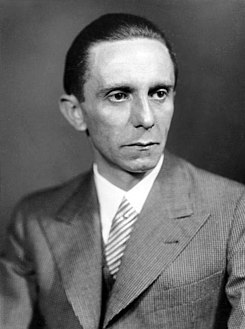 Joseph Goebbels (1933-1945)
Joseph Goebbels (1933-1945)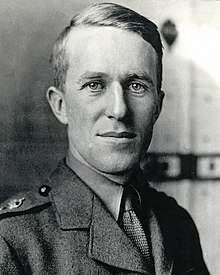 Thomas edward Lawrence (1916-1918)
Thomas edward Lawrence (1916-1918)
